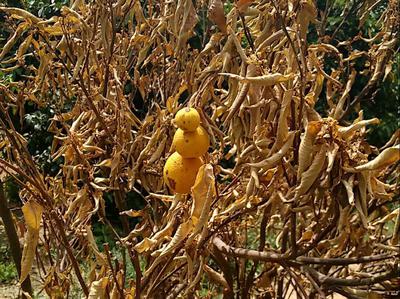Blast of Citrus
Pseudomonas syringae pv. syringae
Bacteria
In a Nutshell
- Water soaked lesions and dark brown blotches develop on young growth, which usually originate at the base of the leaf blade or at the auxiliary bud Leaves become dried and rolled, before eventually dropping off.
Can also be found in
Symptoms
Characteristic disease symptoms are the presence of water-soaked lesions at the base of the leaf blade and black areas on the petiole. Later, these lesions extend to the midvein of leaves and to the twigs surrounding the base of the petiole. Later on, the leaves dry and curl, but still, remain firmly attached to the branch. Eventually, they fall, usually without petioles. The necrotic areas on twigs further enlarge and the twigs may be eventually killed within 20-30 days if they become completely girdled. Nursery stocks may become blighted in the question of days, the symptoms being somewhat similar to those caused by Phytophthora attack. The symptoms are less severe or may even revert with the onset of warm or dry weather. Fruit infection is seen occasionally in oranges in the form of small black pits on the skin. Orange, lemon and mandarin trees show the worst symptoms.
Recommendations

Organic Control
As of today, no biological treatment is known to control the incidence or severity of this disease. Please notify us, if you know of any. Sprays of copper formulations such as Bordeaux mixtures are acceptable and recommended for use in organically managed citrus groves.

Chemical Control
Always consider an integrated approach with preventive measures together with biological treatments if available. Sprays of copper formulations such as Bordeaux mixtures are acceptable and recommended for use, even in organically managed citrus groves. Apply treatments each year at the onset of cool, wet periods. Adding ferric chloride or mancozeb to cupric hydroxide provides good control of the strains that may have developed resistance over the years.
What caused it?
Citrus blast is caused by the bacteria Pseudomonas syringae pv. syringae, which infect several citrus varieties. These bacteria usually dwell on the surface of the leaves and become pathogenic during prolonged periods of wet weather. It enters plant tissues through the leaf natural pores or leaf scars or via wounds in stems. Injuries to tissues, such as those occurring during wind, driving rain, sandblasting and frost, facilitate the entry of the bacteria into the plant. Several days of prolonged leaf moisture appear to be required for infection to take place. Young leaves that have not completely matured or hardened off before winter are most susceptible.
Preventive Measures
- Use bushy varieties with relatively few thorns to prevent wind injury.
- Plan windbreaks to protect the trees from strong winds.
- Prune out dead or diseased twigs in spring after the rainy period to reduce the spread of the disease.
- Schedule fertilization during spring or early summer, as this will enhance new growth during unfavorable conditions for the bacteria.



